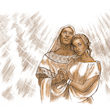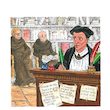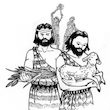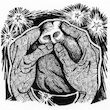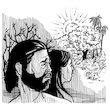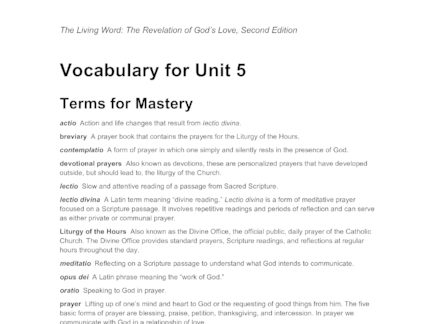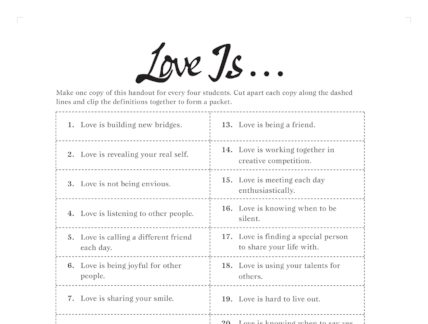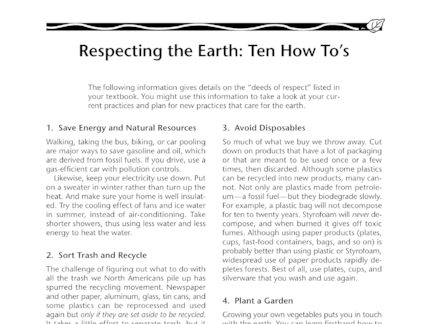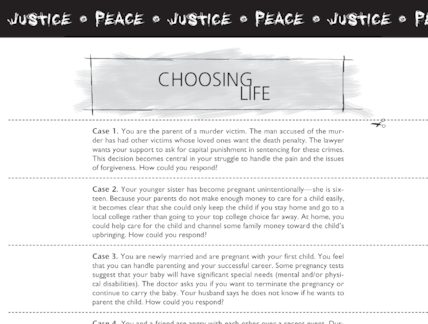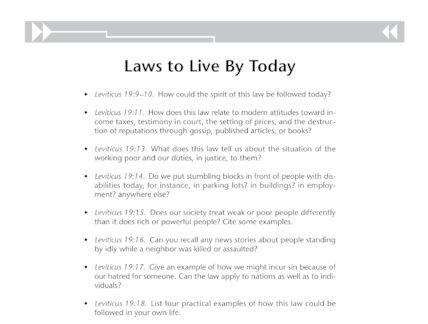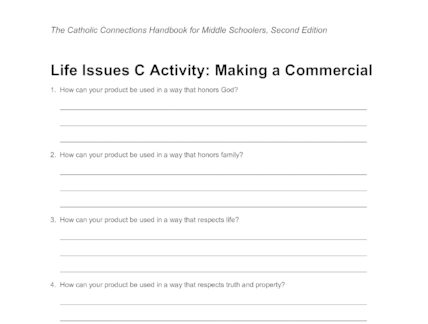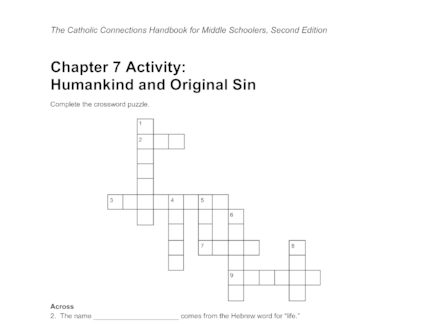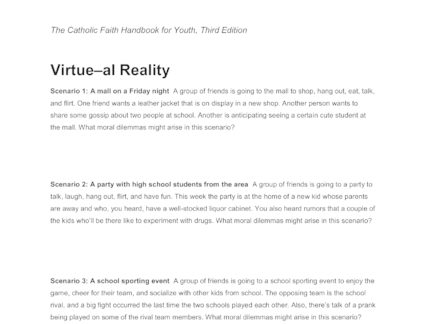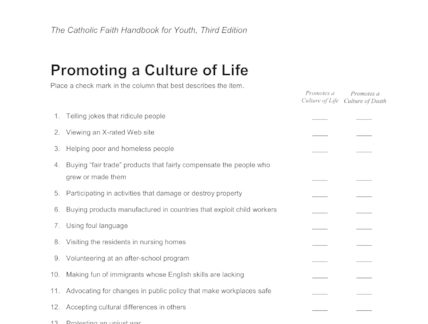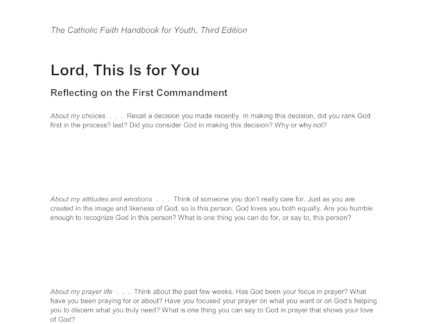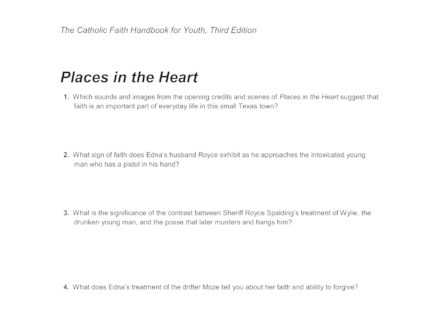Video
CST 101 | Call to Family, Community, and Participation
Video
CST 101 | Option for the Poor and Vulnerable
Video
Kid President - How to Change the World (a work in progress)
Video
The Body of Christ
Video
CST 101 | Life and Dignity of the Human Person
Video
CST 101 | Care for God's Creation
Video
Pope Francis Joins Religious Leaders of Different Faiths, in Fight against Modern Slavery
Video
Don’t Laugh at Me
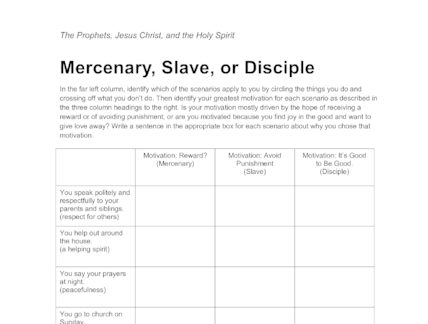
Document
Mercenary, Slave, or Disciple
Students identify their motivation for doing good deeds before reflecting on the role of grace in their lives.
Video
Consider the Lilies
Video
St. Teresa's Prayer
Video
Open the Eyes of My Heart
Video
Let Faith Arise
Video
Do This in Memory
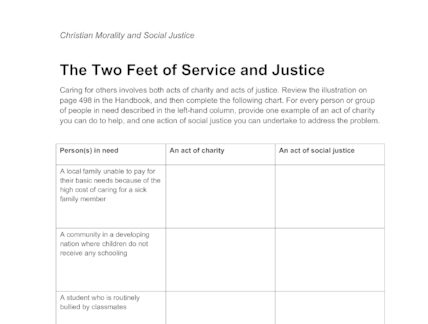
Document
The Two Feet of Service and Justice
This chart provides students space to create examples of acts of charity and social justice for several real-life situations.
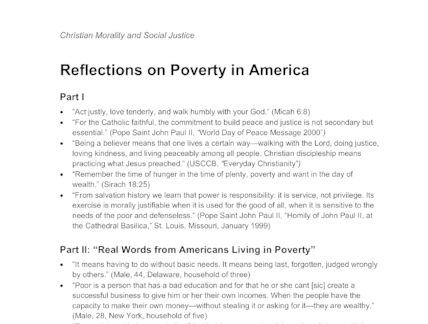
Document
Reflections on Poverty in America
This handout provides a series of Scripture passages and real-life accounts to help students reflect on poverty in America.
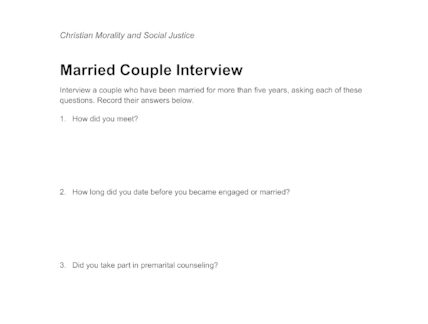
Document
Married Couple Interview
This handout provides the outline for an interview of a married couple.
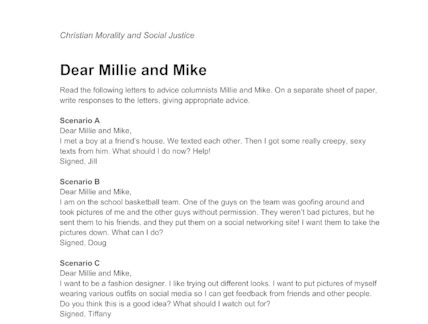
Document
Dear Millie and Mike
This handout provides several real-life situations that teens might encounter. Students are challenged to respond to the situations and give advice to other teens.
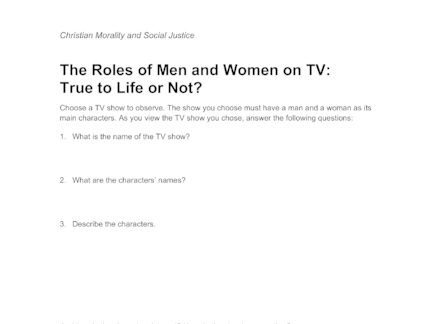
Document
The Roles of Men and Women on TV: True to Life or Not?
This handout provides questions for students to answer as they observe the roles of men and women on TV.
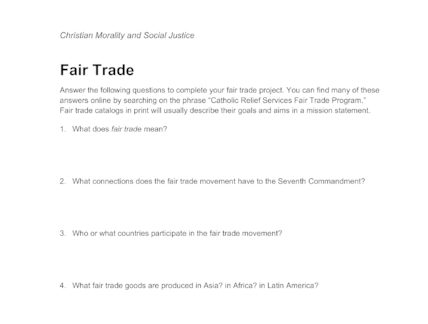
Document
Fair Trade
This worksheet provides questions for students to answer as they research and learn about the Fair Trade Movement.
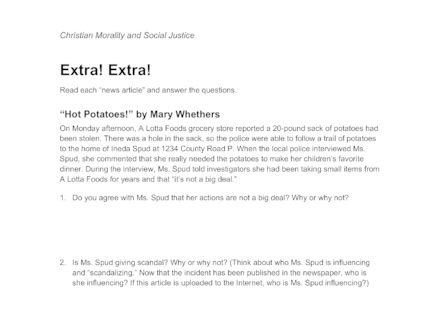
Document
Extra! Extra!
Students read two “news articles” and evaluate the morality of each by answering a series of questions.
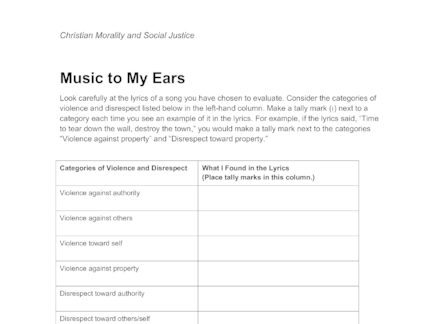
Document
Music to My Ears
Students evaluate a contemporary piece of music based on several different categories of violence and disrespect.
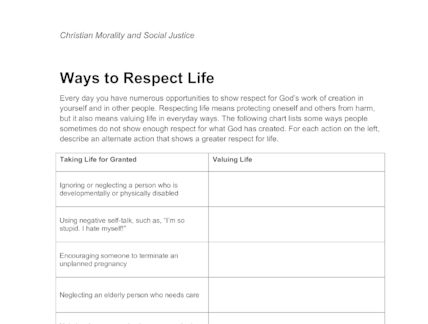
Document
Ways to Respect Life
This worksheet challenges students to think about how they can value the dignity of life on a day-to-day basis.
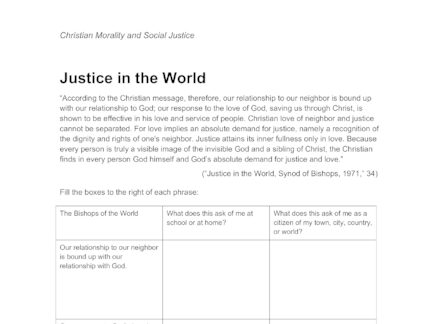
Document
Justice in the World
This worksheet challenges students to think about how the teachings about Justice from the Bishops of the World apply to their daily lives.
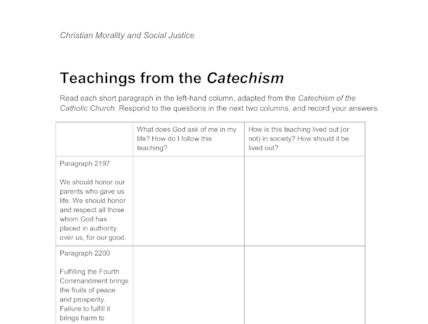
Document
Teachings from the Catechism
This worksheet challenges students to think about how the teachings from the Catechism on the fourth commandment apply to their daily lives.
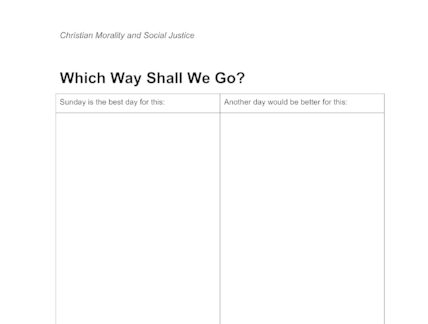
Document
Which Way Shall We Go?
This handout provides a chart for students to list activities that are best to do on Sunday and those that should be saved for other days of the week.

Document
A Doctrinal Scavenger Hunt
A scavenger hunt to find important Church doctrines, teachings and beliefs in the Catechism.
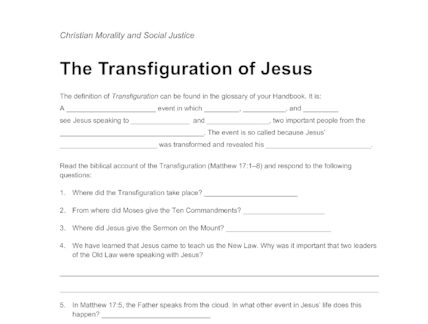
Document
The Transfiguration of Jesus
This worksheet helps students to read Scripture passages, answer questions about, and understand the importance of the Transfiguration of Jesus.
Video
Song/video "Lord, I Need You"
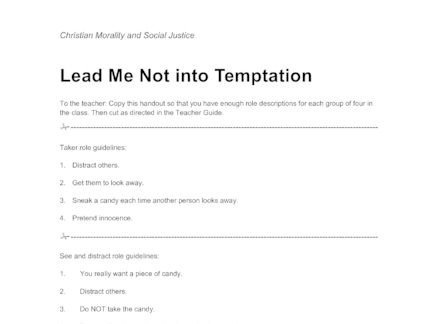
Document
Lead Me Not into Temptation
This handout presents different roles for students to act out from a real-life theft situation
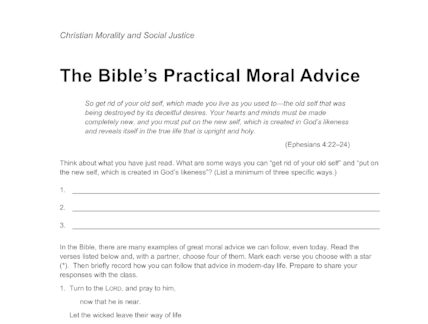
Document
The Bible’s Practical Moral Advice
This worksheet guides students as they look up Scripture passages that give moral advice.
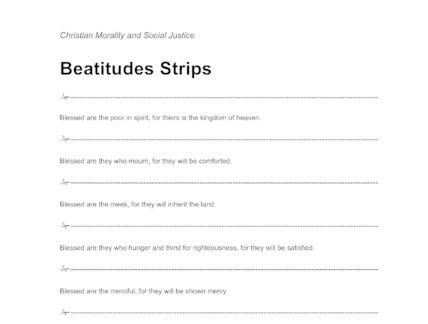
Document
Beatitudes Strips
A list of the Beatitudes organized to be cut into strips for a class activity.
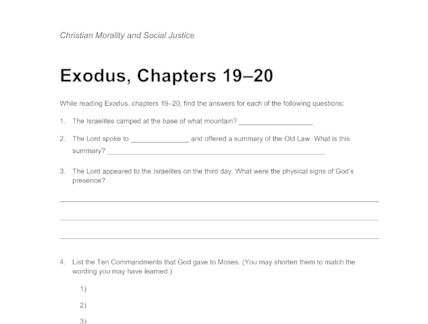
Document
Exodus, Chapters 19–20
This handout provides a note-taking guide while reading chapters 19-20 from Exodus.
Video
Here I Am, Lord (Nature Scenes)
Video
The Face of Christ (Black & White)
Video
Come to the Water
Video
What Is Catholic Social Teaching?
Video
Words
Video
Saint Mother Teresa—Inspiring ‘Everyone, Everywhere,’
Video
What Is Social Justice?
Video
Voices of Youth on Social Justice
Video
Wrecking Ball
Video
Song/video "Man in the Mirror"
Video
"Praise God from Whom All Blessings Flow"
Video
Crystalina’s Testimony (Part 1)—Love or Lust?
Video
Hold Me
Video
Servant Song
Video
Song "You Are Near"
Video
Hey, World
Video
Hope in Front of Me
Video
Live Like That
Video
Speak Life
Video
Seek Ye First
Video
Song "Word of God Speak"
Video
Video "God Speaks to Man: The Oldest Revelation"
Video
Song/video "God of Wonders”
Video
Ask Me
Video
Hey, World
Video
The Color of Love
Video
Here I Am, Lord
Video
Precepts of the Church
Video
What Are Sins?
Video
Holy Choices: Good Decision Making
Video
The Cardinal Virtues, Part 4: Courage
Video
The Cardinal Virtues, Part 3: Temperance
Video
The Cardinal Virtues, Part 2: Justice
Video
The Cardinal Virtues, Part 1: Prudence
Video
Help Me Find It
Video
The Sermon on the Mount and the Lord’s Prayer
Video
The Parable of the Unforgiving Servant
Video
The Parable of the Unforgiving Servant
Presentation
What Is Faith?
This PowerPoint accompanies Unit 5, Chapter 13, by discussing more deeply the meaning of faith and its connection to religion and belief.
Presentation
Jesus Reveals Our Inherent Dignity
<p>This PowerPoint accompanies Unit 4, Chapter 10, by discussing the inherent dignity of all life as shown to us by Jesus.</p>
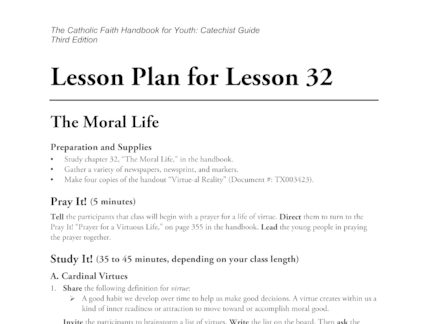
Document
Lesson Plan for Lesson 32
A lesson plan for lesson 32 in The Catholic Faith Handbook for Youth: Catechist Guide. In this lesson students explore what it means to use virtues and grace to live a moral life.
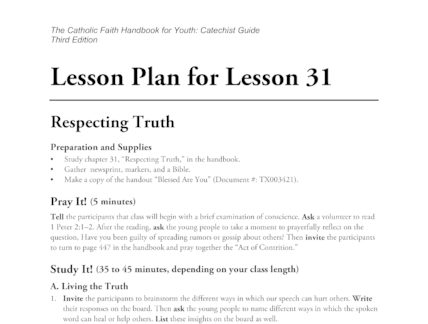
Document
Lesson Plan for Lesson 31
A lesson plan for lesson 31 in The Catholic Faith Handbook for Youth: Catechist Guide. In this lesson students explore what it means to respect truth.
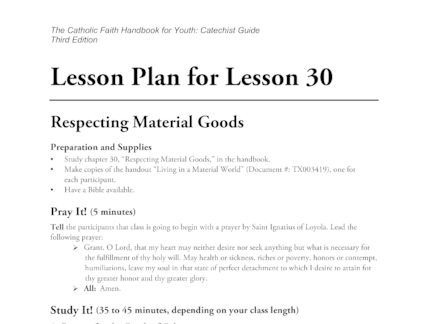
Document
Lesson Plan for Lesson 30
A lesson plan for lesson 30 in The Catholic Faith Handbook for Youth: Catechist Guide. In this lesson students explore what it means to respect material goods.
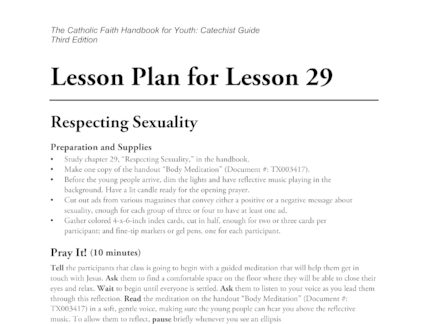
Document
Lesson Plan for Lesson 29
A lesson plan for lesson 29 in The Catholic Faith Handbook for Youth: Catechist Guide. In this lesson students explore what it means to respect the sexuality of ourselves and others.
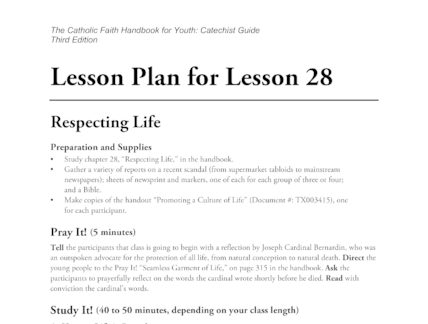
Document
Lesson Plan for Lesson 28
A lesson plan for lesson 28 in The Catholic Faith Handbook for Youth: Catechist Guide. In this lesson students explore what it means to truly respect life.
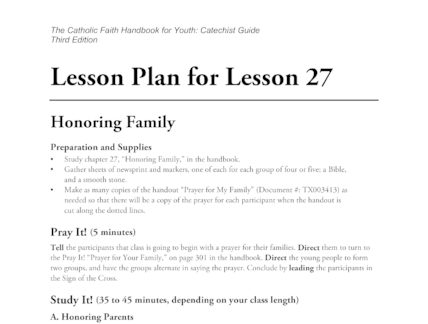
Document
Lesson Plan for Lesson 27
A lesson plan for lesson 27 in The Catholic Faith Handbook for Youth: Catechist Guide.
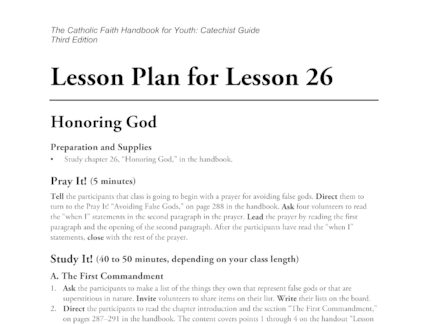
Document
Lesson Plan for Lesson 26
A lesson plan for lesson 26 in The Catholic Faith Handbook for Youth: Catechist Guide.

Document
Lesson Plan for Lesson 25
A lesson plan for lesson 25 in The Catholic Faith Handbook for Youth: Catechist Guide.
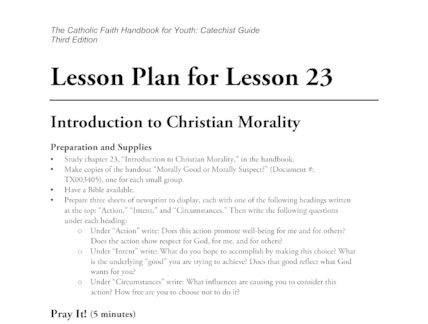
Document
Lesson Plan for Lesson 23
A lesson plan for lesson 23 in The Catholic Faith Handbook for Youth: Catechist Guide.
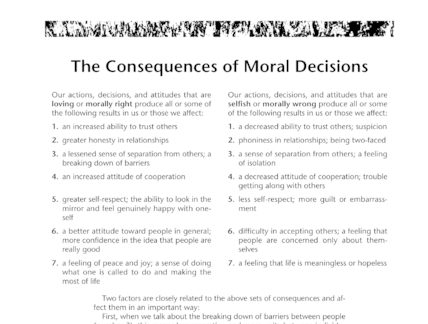
Document
The Consequences of Moral Decisions
This handout examines how actions, attitudes, and decisions affect ourselves and the people around us
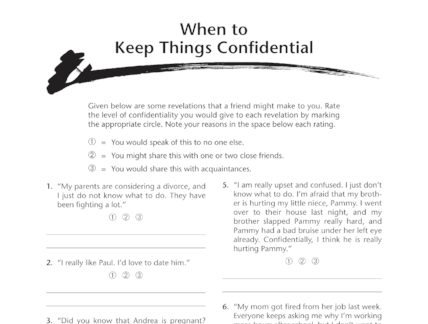
Document
When To Keep Things Confidential
After reading several pieces of information that might be shared by a friend, students decide which should be kept confidential and which might be shared with others.
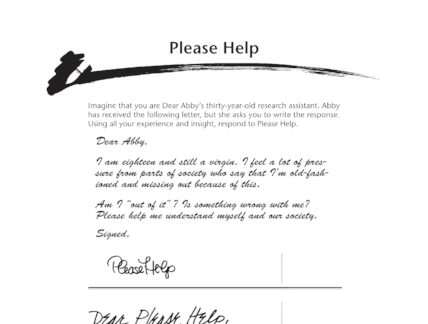
Document
Please Help
This is a writing prompt to help students reflect on what it is like to be a virgin in society today.
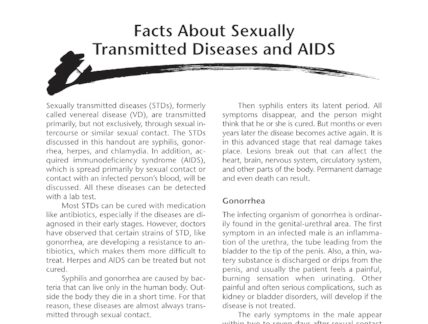
Document
Facts About Sexually Transmitted Diseases and AIDS
This article gives information about common STDs and AIDS.

Document
Questionnaire on Sexually Transmitted Diseases and AIDS
This handout provides a list of True/False statements about sexually transmitted diseases and AIDS.
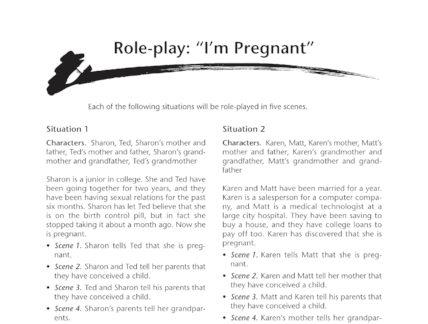
Document
Role-play: "I'm Pregnant"
This handout provides two role-play situations in which a couple has discovered they are pregnant.
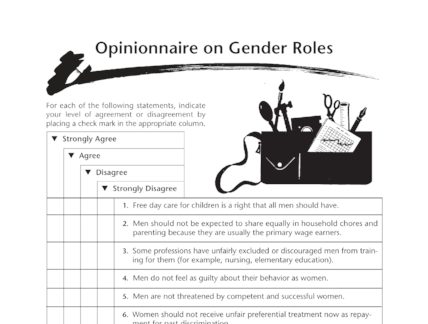
Document
Opinionnaire on Gender Roles (Part 2)
Students share their opinions in response to a series of statements about gender roles in society.
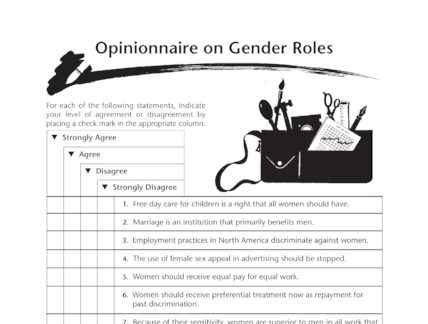
Document
Opinionnaire on Gender Roles (Part 1)
Students share their opinions in response to a series of statements about gender roles in society.
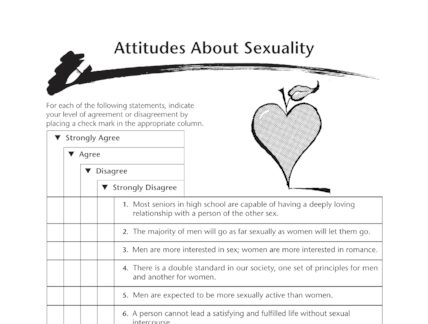
Document
Attitudes About Sexuality
This handout presents a series of statements about sexuality. Students are to indicate their level of agreement or disagreement with each.
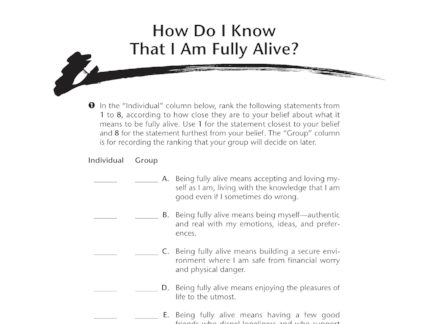
Document
How Do I Know That I Am Fully Alive?
This handout asks students to rank statements according to their beliefs about what it means to be fully alive.
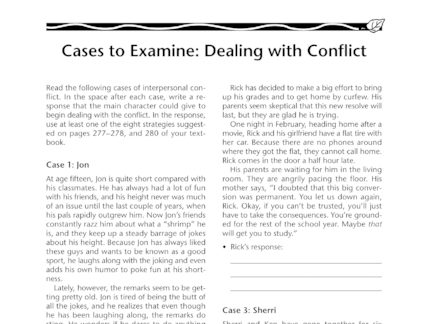
Document
Cases to Examine: Dealing with Conflict
This handout provides three situations for students to read and evaluate. Students must give a suggestion for how to respond to the conflict in each scenario based on the strategies in the book.
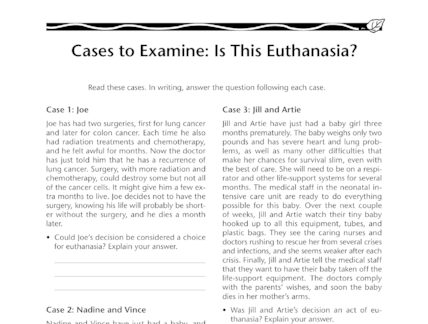
Document
Cases to Examine: Is This Euthanasia?
This handout provides three situations for students to read and evaluate. Students must decide if the story shows an example of Euthanasia.
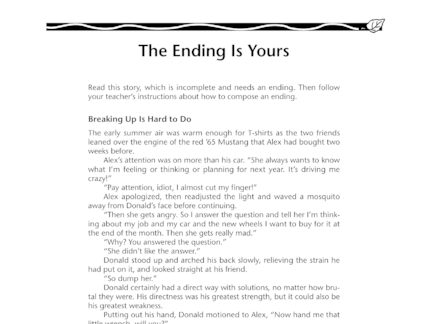
Document
The Ending is Yours
This handout provides the beginning of a story about a teen who is about to break up with his girlfriend. Students are to complete the story following teacher instructions.
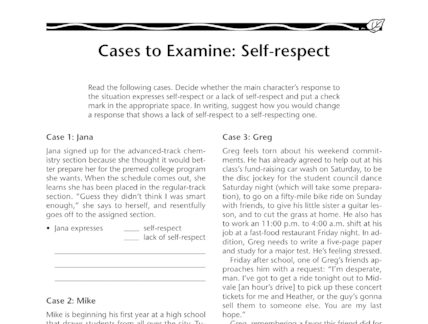
Document
Cases to Examine: Self-respect
This handout provides three situations where teenagers are not fully respecting themselves. Students read the situations and respond with suggestions that demonstrate more self-respect.

Document
Role-plays: Kindness and Truth
This handout provides two role-play situations for students to practice open, honest communication in a kind, truthful way.
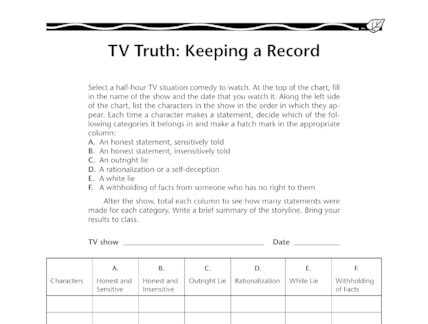
Document
TV Truth: Keeping a Record
This handout provides a chart to help students keep track of the types of truths and lies portrayed on TV.

Document
An Inventory on Money Matters
This handout provides a chart to help students keep track of their expenditures during one week

Document
Perspectives on Sex
This handout provides several comments from teenagers about sex. It can be used as a discussion starter or writing prompt.
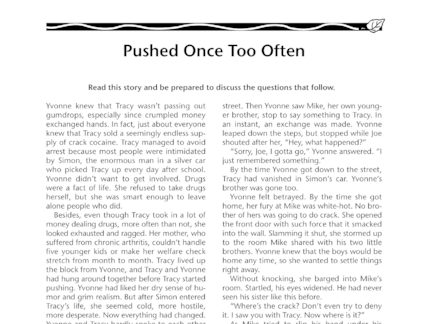
Document
Pushed Once Too Often
This handout presents a story about drug pushing in a school community. Students are challenged to reflect on several questions regarding the situation.
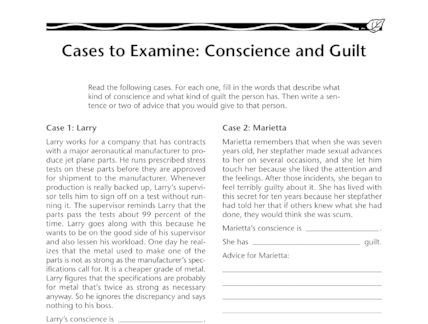
Document
Cases to Examine: Conscience and Guilt
Read the following cases. For each one, fill in the words that describe what kind of conscience and what kind of guilt the person has. Then write a sentence or two of advice that you would give to that person.

Document
The LISTEN Model
Briefly describe below a moral dilemma that an individual might face. For each section of the LISTEN process, fill in one or more things a person facing this dilemma might need to consider.
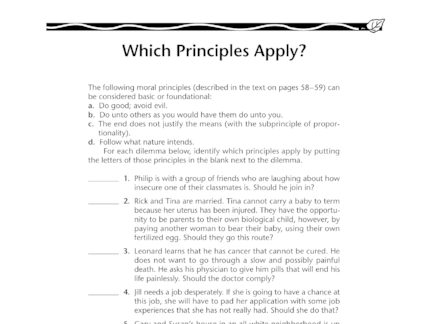
Document
Which Principles Apply?
he following moral principles (described in the text on pages 58–59) can be considered basic or foundational: a. Do good; avoid evil. b. Do unto others as you would have them do unto you. c. The end does not justify …

Document
Getting to Know My Parents' Views
This checklist will help you identify how well you understand your parents’ (or guardians’) views on moral issues and whether you think that your parents understand your views on moral issues.

Document
"O Lord, You Have Searched Me and Known Me"
Spend a few moments quietly asking God to help you see clearly and honestly into your heart and mind as you begin this examination of conscience. Write your responses to the questions below. No one will collect this handout.
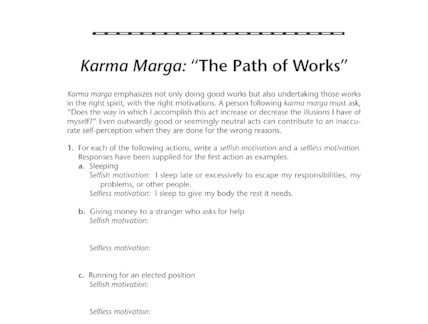
Document
Karma Marga: "The Path of Works"
For each of the following actions, write a selfish motivation and a selfless motivation. Responses have been supplied for the first action as examples.
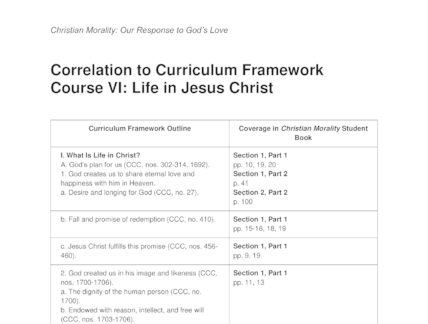
Document
Correlation to Curriculum Framework
Correlation to Curriculum Framework Course VI: Life in Jesus Christ from Christian Morality: Our Response to God’s Love.
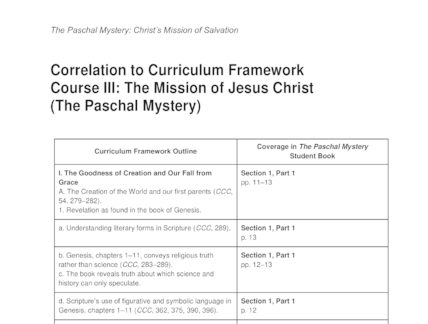
Document
Correlation to Curriculum Framework
Correlation to Curriculum Framework Course III: The Mission of Jesus Christ (The Paschal Mystery) from The Paschal Mystery: Christ’s Mission of Salvation.
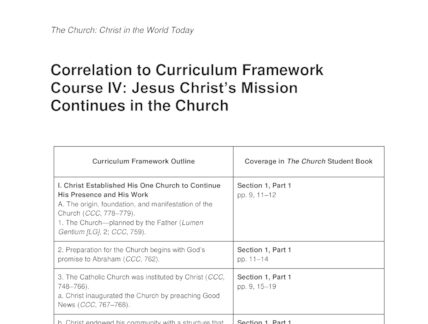
Document
Correlation to Curriculum Framework
Correlation to Curriculum Framework Course IV: Jesus Christ’s Mission Continues in the Church from The Church: Christ in the World Today.
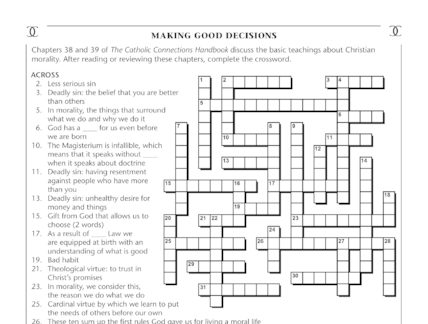
Document
Making Good Decisions
Chapters 38 and 39 of The Catholic Connections Handbook discuss the basic teachings about Christian morality. After reading or reviewing these chapters, complete the crossword.
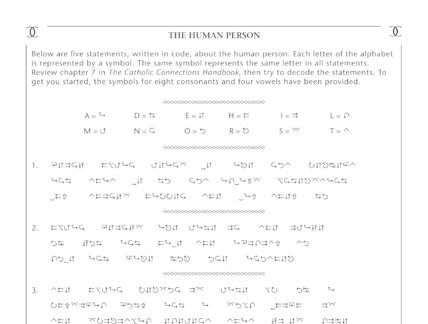
Document
The Human Person
Below are five statements, written in code, about the human person. Each letter of the alphabet is represented by a symbol. The same symbol represents the same letter in all statements. Review chapter 7 in The Catholic Connections Handbook, then …
Video
What is Catholic Social Teaching?
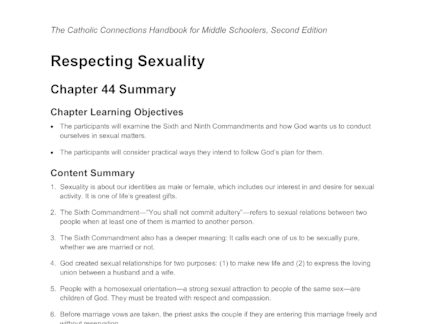
Document
Chapter 44 Summary: Respecting Sexuality
A nice summary of the Sixth and Ninth Commandments, and how God wants us to conduct ourselves in sexual matters.
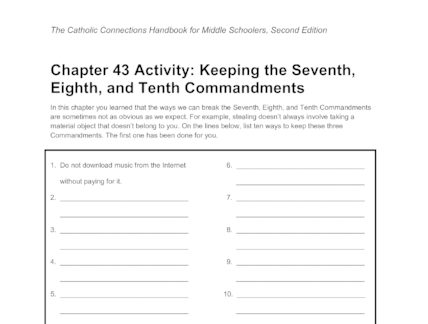
Document
Chapter 43 Activity: Keeping the Seventh, Eighth, and Tenth Commandments
Students are asked to list 10 practical ways to keep the 7th, 8th, and 10th Commandments.
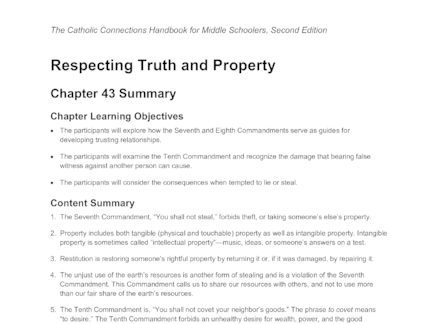
Document
Chapter 43 Summary: Respecting Truth and Property
A summary of Chapter 43, Respecting Truth and Property from the Catholic Connections Handbook for Middle Schoolers, Second Edition.
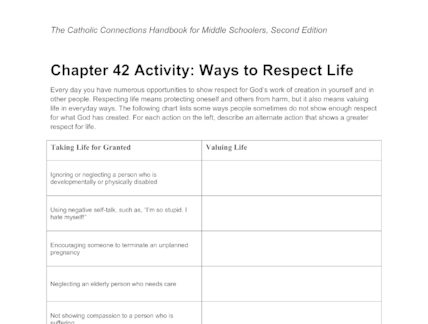
Document
Chapter 42 Activity: Ways to Respect Life
Every day you have numerous opportunities to show respect for God’s work of creation in yourself and in other people. Respecting life means protecting oneself and others from harm, but it also means valuing life in everyday ways. The following …
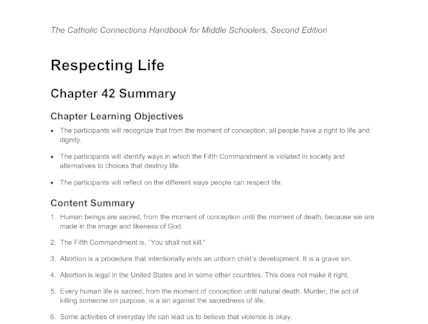
Document
Chapter 42 Summary: Respecting Life
A summary of Chapter 42, Respecting Life from the Catholic Connections Handbook for Middle Schoolers, Second Edition.
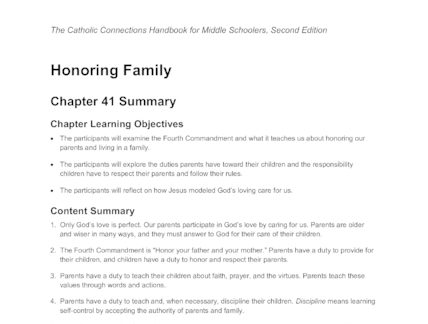
Document
Chapter 41 Summary: Honoring Family
A summary of Chapter 41, Honoring Family from the Catholic Connections Handbook for Middle Schoolers, Second Edition.
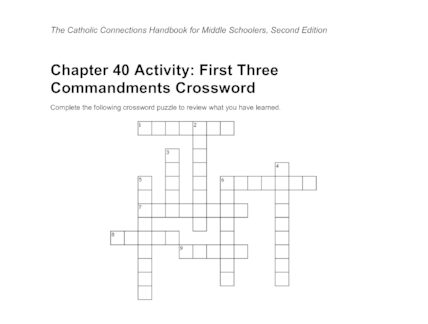
Document
Chapter 40 Activity: First Three Commandments Crossword
Complete the following crossword puzzle to review what you have learned.
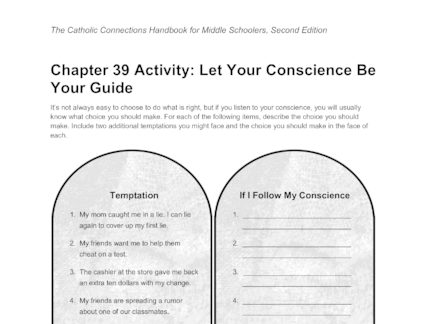
Document
Chapter 39 Activity: Let Your Conscience Be Your Guide
It’s not always easy to choose to do what is right, but if you listen to your conscience, you will usually know what choice you should make. For each of the following items, describe the choice you should make. Include …

Document
Chapter 39 Summary: Moral Decision Making
A summary of Chapter 39, Moral Decision Making from the Catholic Connections Handbook for Middle Schoolers, Second Edition.

Document
Chapter 38 Activity: How Do I Make Moral Decisions?
When you have a difficult moral decision to make, how do you go about figuring out what you should do? Do you talk with your friends or a parent or other adult, or do you pray about it? For some …
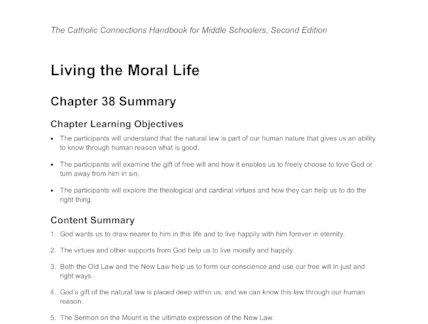
Document
Chapter 38 Summary: Living the Moral Life
A summary of Chapter 38, Living the Moral Life from the Catholic Connections Handbook for Middle Schoolers, Second Edition.
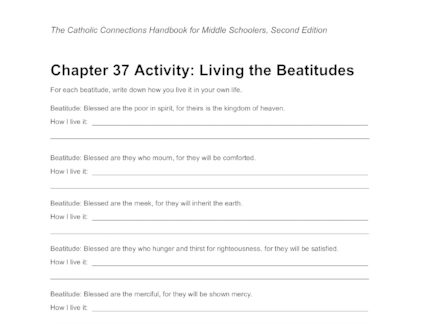
Document
Chapter 37 Activity: Living the Beatitudes
For each beatitude, write down how you live it in your own life.
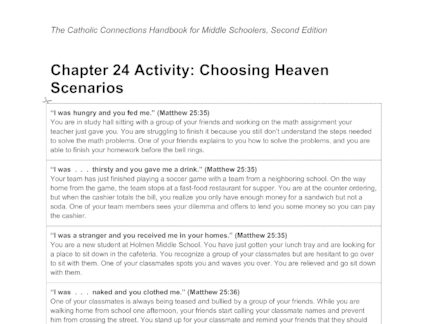
Document
Chapter 24 Activity: Choosing Heaven Scenarios
How to respond in various life issues situations.
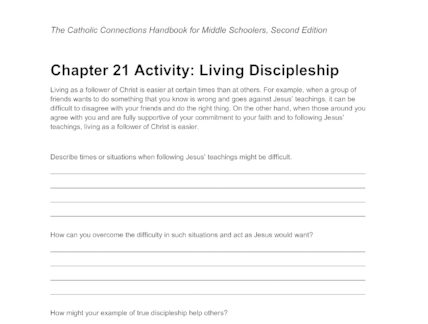
Document
Chapter 21 Activity: Living Discipleship
Living as a follower of Christ is easier at certain times than at others. For example, when a group of friends wants to do something that you know is wrong and goes against Jesus’ teachings, it can be difficult to …
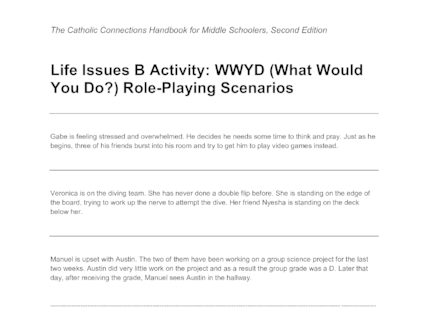
Document
Life Issues B Activity: WWYD (What Would You Do?) Role-Playing Scenarios
How you would respond to different life issue scenarios.
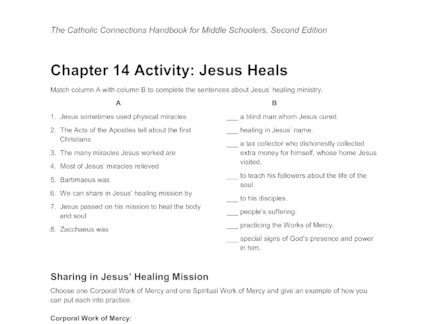
Document
Chapter 14 Activity: Jesus Heals
Match column A with column B to complete the sentences about Jesus’ healing ministry.
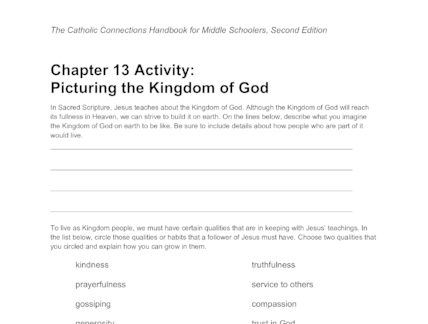
Document
Chapter 13 Activity: Picturing the Kingdom of God
In Sacred Scripture, Jesus teaches about the Kingdom of God. Although the Kingdom of God will reach its fullness in Heaven, we can strive to build it on earth. On the lines below, describe what you imagine the Kingdom of …
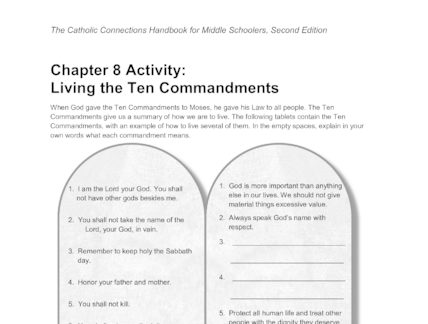
Document
Chapter 8 Activity: Living the Ten Commandments
When God gave the Ten Commandments to Moses, he gave his Law to all people. The Ten Commandments give us a summary of how we are to live. The following tablets contain the Ten Commandments, with an example of how …
Video
Celebrating Life: The Human Person and the Rules of God
Video
Bad News Becomes Good
Video
It's Never Too Late to Claim Chastity
Video
Obedience to God's Will: Our Greatest Happiness
Presentation
Chapter 32
A PowerPoint presentation with information from The Catholic Faith Handbook for Youth, Third Edition Chapter 32, The Moral Life.
Presentation
Chapter 31
A PowerPoint presentation with information from The Catholic Faith Handbook for Youth, Third Edition Chapter 31, Respecting Truth.
Presentation
Chapter 30
A PowerPoint presentation with information from The Catholic Faith Handbook for Youth, Third Edition Chapter 30, Respecting Material Goods.
Presentation
Chapter 29
A PowerPoint presentation with information from The Catholic Faith Handbook for Youth, Third Edition Chapter 29, Respecting Sexuality.
Presentation
Chapter 28: In-Depth
A PowerPoint presentation with information from The Catholic Faith Handbook for Youth, Third Edition Chapter 28, Life Issues: War.
Presentation
Chapter 27
A PowerPoint presentation with information from The Catholic Faith Handbook for Youth, Third Edition Chapter 27, Honoring Family.
Presentation
Chapter 25
A PowerPoint presentation with information from The Catholic Faith Handbook for Youth, Third Edition Chapter 25, Sources of Moral Truth.
Presentation
Chapter 23
A PowerPoint presentation with information from The Catholic Faith Handbook for Youth, Third Edition Chapter 23, Introduction to Christian Morality.
Presentation
Chapter 15
A PowerPoint on The Catholic Faith Handbook for Youth, Third Edition Chapter 15, The Last Things.
Presentation
Chapter 6
A PowerPoint on The Catholic Faith Handbook for Youth, Third Edition Chapter 6, The Human Person.
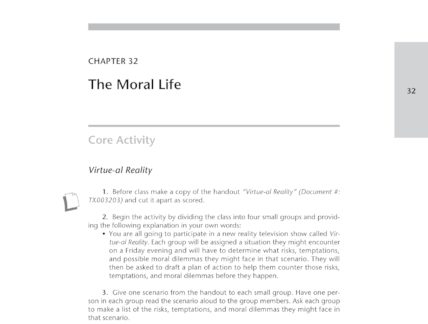
Document
Chapter 32 Activities
Activities for Chapter 32 The Moral Life including a core activity, core activity extension, and additional activities.
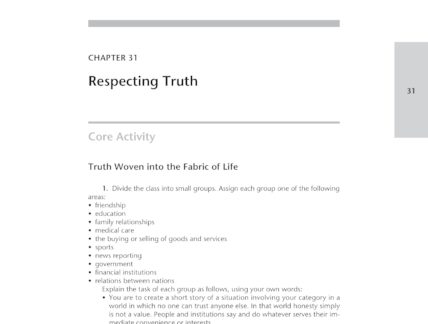
Document
Chapter 31 Activities
Activities for Chapter 31 Respecting Truth including a core activity, core activity extension, and additional activities.
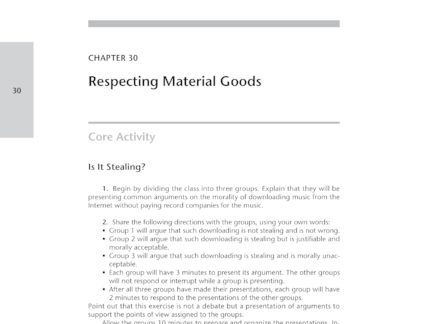
Document
Chapter 30 Activities
Activities for Chapter 30 Respecting Material Goods including a core activity, core activity extension, and additional activities.
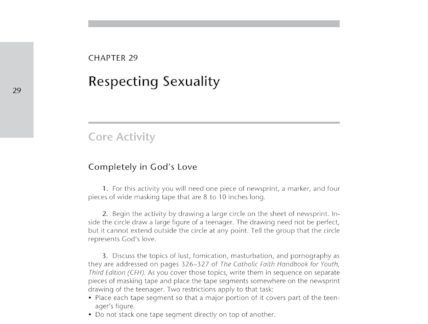
Document
Chapter 29 Activities
Activities for Chapter 29 Respecting Sexuality including a core activity, core activity extension, and additional activities.
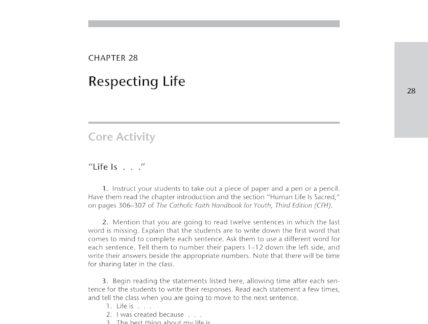
Document
Chapter 28 Activities
Activities for Chapter 28 Respecting Life including a core activity, core activity extension, and additional activities.
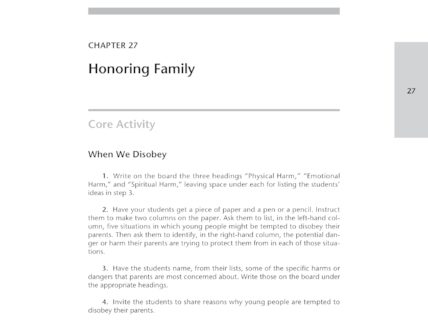
Document
Chapter 27 Activities
Activities for Chapter 27 Honoring Family including a core activity, core activity extension, and additional activities.
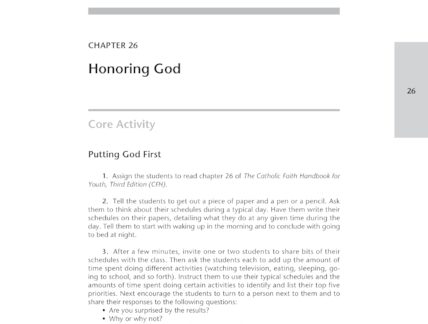
Document
Chapter 26 Activities
Activities for Chapter 26 Honoring God including a core activity, core activity extension, and additional activities.
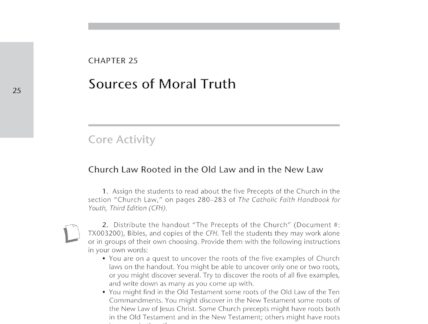
Document
Chapter 25 Activities
Activities for Chapter 25 Sources of Moral Truth including a core activity, core activity extension, and additional activities.
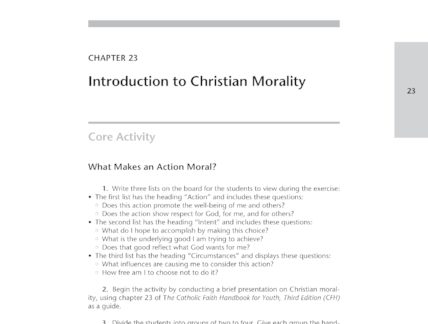
Document
Chapter 23 Activities
Activities for Chapter 23 Introduction to Christian Morality including a core activity, core activity extension, and additional activities.
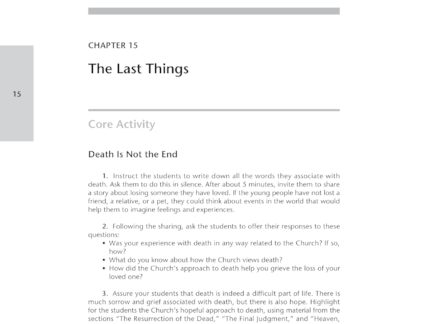
Document
Chapter 15 Activities
Activities for Chapter 15 The Last Things, including a core activity, core activity extension, and additional activities.
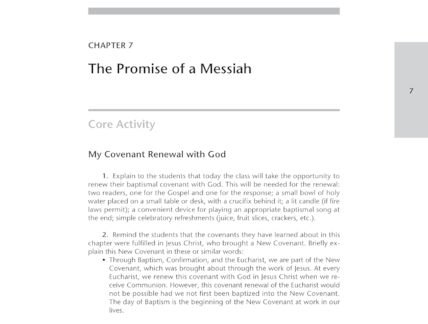
Document
Chapter 7 Activities
Activities for Chapter 7 The Promise of a Messiah, including a core activity, core activity extension, and additional activities.

Document
Chapter 6 Activities
Activities for Chapter 6 The Human Person, including a core activity, core activity extension, and additional activities.
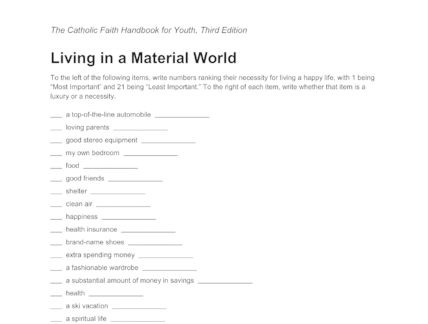
Document
Living in a Material World
A worksheet where students are asked to rank items on their necessity for living a happy life.
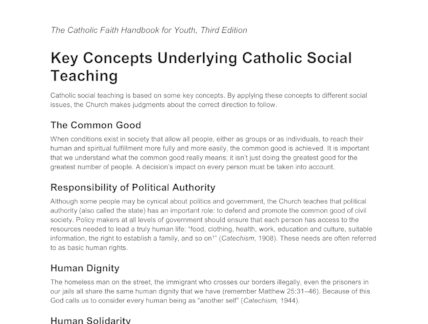
Document
Handout: Key Concepts Underlying Catholic Social Justice Teachings
Catholic social teaching is based on some key concepts. By applying these concepts to different social issues, the Church makes judgments about the correct direction to follow.
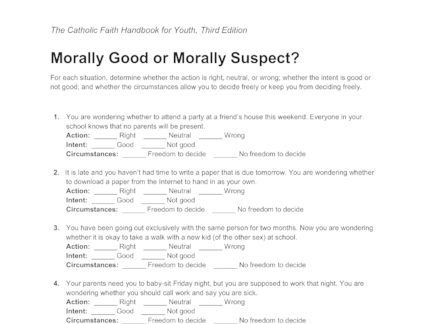
Document
Handout: Morally Good or Morally Suspect
For each situation, determine whether the action is right, neutral, or wrong; whether the intent is good or not good; and whether the circumstances allow you to decide freely or keep you from deciding freely.
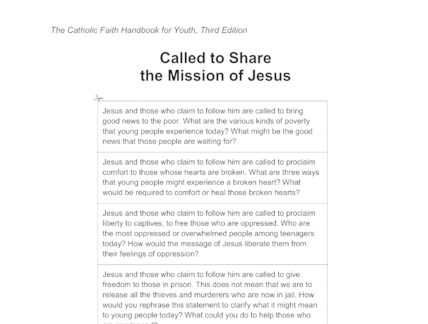
Document
Called to Share the Mission of Jesus
Questions about how we can imitate Jesus’ example in the way we interact with others.
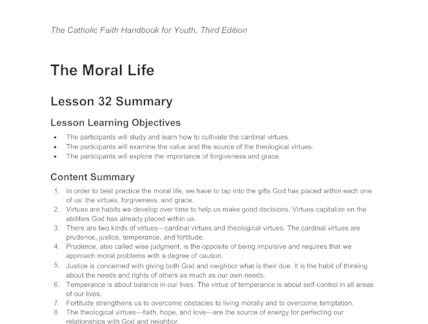
Document
Lesson 32 Summary
The lesson learning objectives and content summary for Lesson 32, The Moral Life.
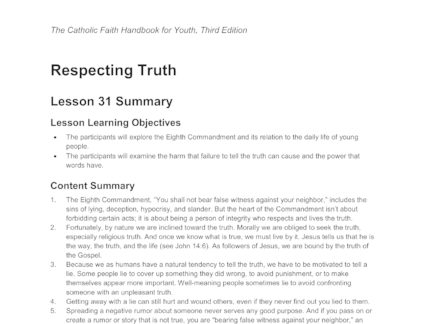
Document
Lesson 31 Summary
The lesson learning objectives and content summary for Lesson 31, Respecting Truth.

Document
Living in a Material World
Consider the following list of things. Which of them is necessary for you to have in order to be happy? Place a check mark in front of each one you feel is necessary.
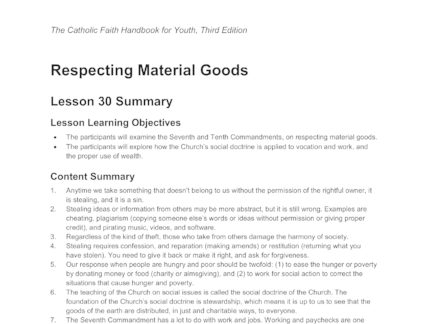
Document
Lesson 30 Summary
The lesson learning objectives and content summary for Lesson 30, Respecting Material Goods.
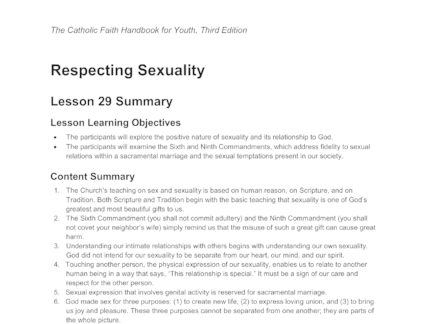
Document
Lesson 29 Summary
The lesson learning objectives and content summary for Lesson 29, Respecting Sexuality.
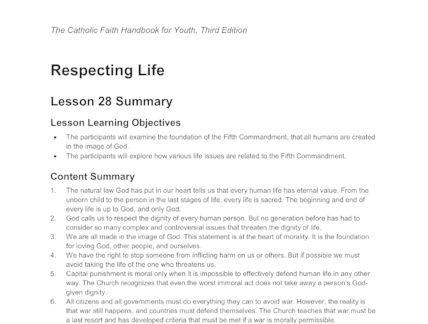
Document
Lesson 28 Summary
The lesson learning objectives and content summary for Lesson 28, Respecting Life.
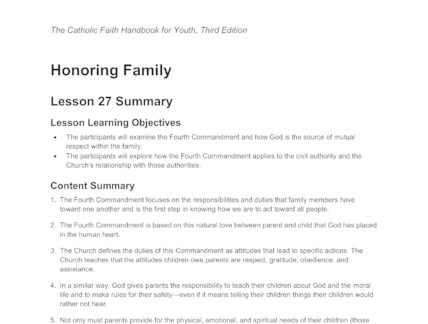
Document
Lesson 27 Summary
The lesson learning objectives and content summary for Lesson 27, Honoring God.
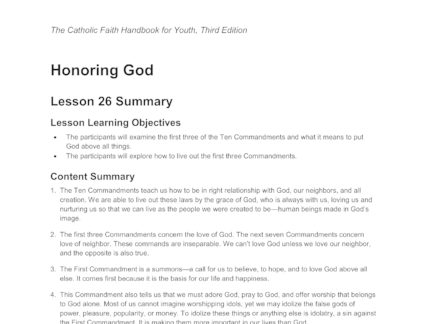
Document
Lesson 26 Summary
The lesson learning objectives and content summary for Lesson 26, Honoring God.
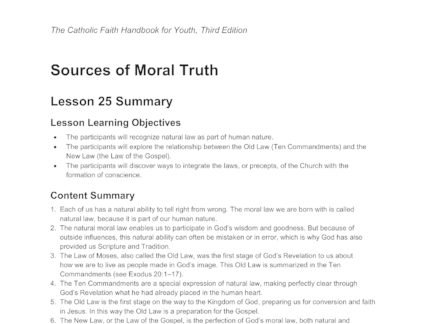
Document
Lesson 25 Summary
The lesson learning objectives and content summary for Lesson 25, Sources of Moral Truth.
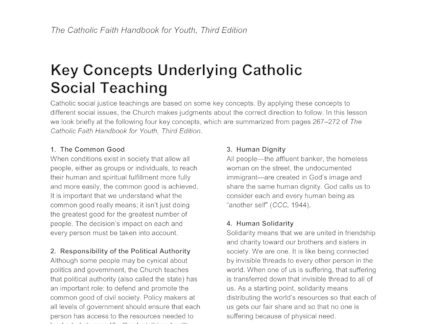
Document
Key Concepts Underlying Catholic Social Teaching
Catholic social justice teachings are based on some key concepts. By applying these concepts to different social issues, the Church makes judgments about the correct direction to follow. In this lesson we look briefly at the following four key concepts, …
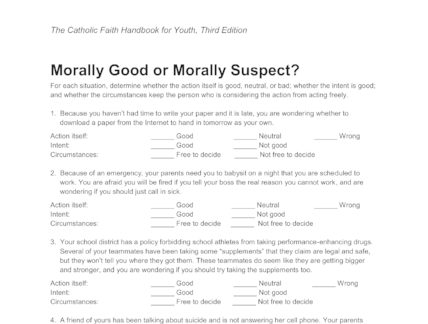
Document
Morally Good or Morally Suspect
For each situation, determine whether the action itself is good, neutral, or bad; whether the intent is good; and whether the circumstances keep the person who is considering the action from acting freely.

Document
Lesson 23 Summary
The lesson learning objectives and content summary for Lesson 23, Introduction to Christian Morality.

Document
A Living Sign of Hope
We believe that because we are transformed by faith in the Risen Jesus, his presence in the world becomes more visible through us. Read the following statements that are based on Jesus’ teachings, and then answer the questions that follow. …
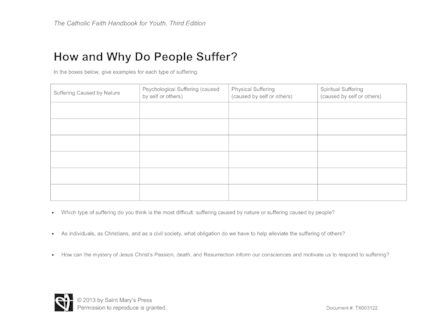
Document
How and Why Do People Suffer?
In the boxes below, give examples for each type of suffering, and respond to the questions that follow.

Document
Core Beliefs Practices and Attitudes of the Catholic Faith
Each statement below is a core belief of the Catholic faith. Choose a symbol (“I get it,” “I’m unsure,” or “I don’t get it”) that best reflects your understanding of each belief. Then briefly explain what you might know about …

Document
What Do I Know about the Catholic Faith
In the time allotted for this exercise, answer each question to the best of your knowledge. Each set of questions corresponds to the units you will study in this course and represents content you will cover in more detail in …
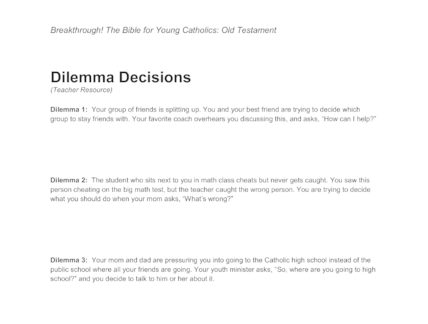
Document
Dilemma Decisions
A worksheet with tough decisions students may be faced with in their lives.
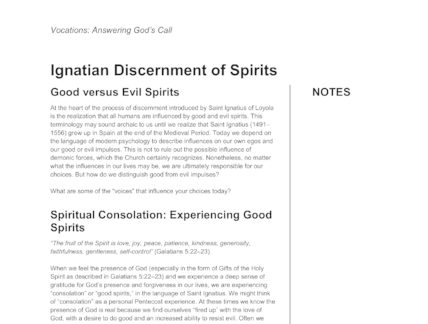
Document
Ignatian Discernment of Spirits
An article that breaks down the differences between good and evil spirits.
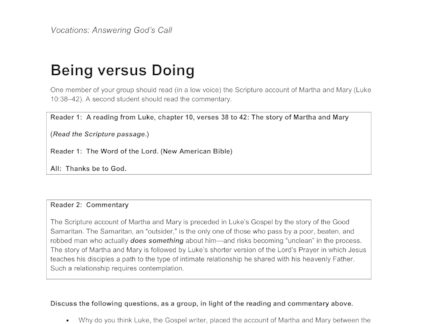
Document
Being versus Doing
A scripture passage from the Gospel of Luke about Martha and Mary is read along with a commentary, and is followed by large group discussion questions.
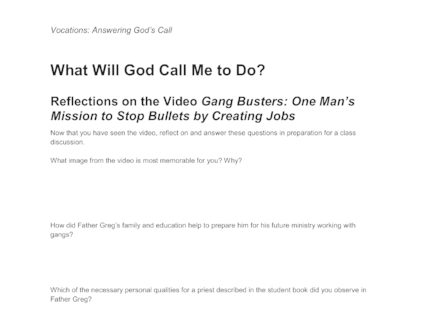
Document
What Will God Call Me to Do
A reflection worksheet and class discussion on the video Gang Busters: One Man’s Mission to Stop Bullets by Creating Jobs.
Presentation
Marriage: A Call to Fruitfulness
A PowerPoint about marriage, children, natural family planning, in vitro fertilization, and abortion.
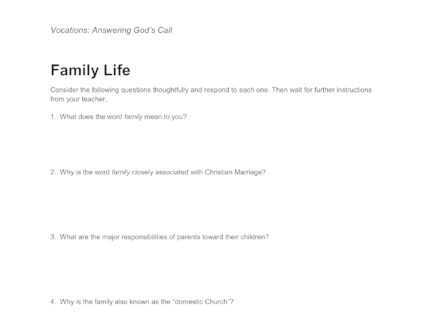
Document
Family Life
A worksheet with questions about the meaning of the family, the responsibilities of parents, the domestic Church, as well as the influence parents have on their children in their moral and spiritual development.
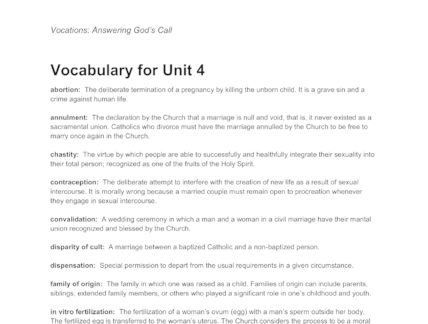
Document
Vocabulary for Unit 4
A vocabulary list from unit 4 that defines the words abortion, annulment, chastity, contraception, convalidation, disparity of a cult, dispensation, family of origin, in vitro fertilization, mixed marriage, and natural family planning.





